Five years ago I tested the then-new ninth-generation Honda Civic, and could hardly have been more disappointed. For decades innovative, idiosyncratic, engineering-driven Honda had offered the best small sedan, the one everyone else emulated. But the company lost the plot a few years ago, and the 2012 Civic looked bad (both inside and out) and drove worse. It remains unclear what happened inside Honda--I'd love to know--but reviews like mine provided a much-needed wake-up call. Honda rushed some improvements to market for the 2013 and has entirely redesigned the Civic for 2016.
I've already compared the top-of-the-line 2016 Honda Civic Touring to the also recently redesigned Chevrolet Cruze (an excellent small sedan) and the recently updated Nissan Sentra (still in need of a full redesign). Those reviews were based on a car borrowed from a Honda dealer. I've now had the mid-range Civic EX with Honda Sensing for a week, and took the opportunity to drive this car back-to-back with the Mazda3 and the fully redesigned 2017 Hyundai Elantra. (The 2017 Elantra isn't yet in our database, so the comparison car is incorrectly displayed as a 2016.)
Is the Civic back on top?
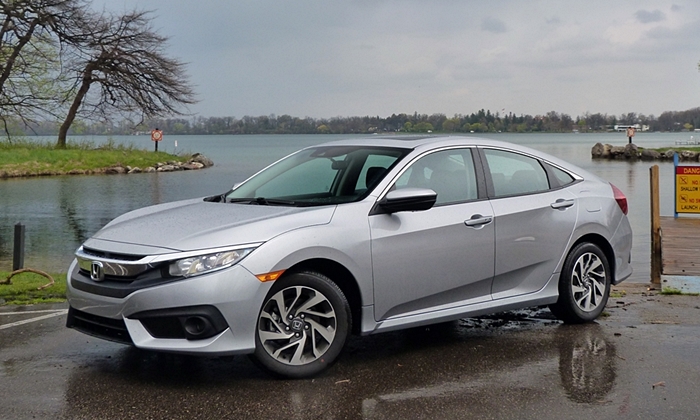
The latest Civic makes a much stronger impression. The car's best angle. more Civic photos
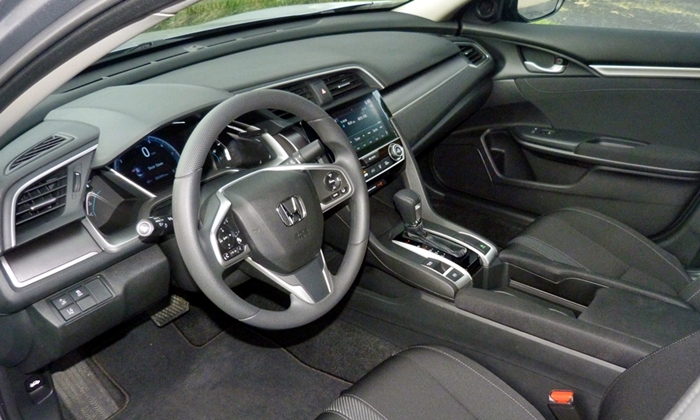
The new Civic's interior appears upscale and sophisticated even in EX trim with black cloth seats.
| |
Compared to the Elantra |
| Price or payments |
 Better
Worse
Better
Worse
|
The $27,335 window sticker on the new Honda Civic Touring might seem steep for a small sedan, but it undercuts the new Chevrolet Cruze by nearly $2,000 after a $600 adjustment for additional content. The Civic Touring is loaded with features that weren't even available in this class a couple years ago, most notably all-speed adaptive cruise control, both low- and high-speed automatic braking, and lane keep assist.
The new Hyundai Elantra offers a safety tech package that is about as comprehensive as the Civic's, but only on a fully-equipped top-of-the-range Limited, with a sticker price of $27,585. Yes, even an equivalent Hyundai lists for more than the Honda. (Granted, discounts and incentives are currently a few thousand higher on the Hyundai.)
In contrast to Hyundai's strategy with the Elantra, Honda offers its "Honda Sensing" package for just $1,000 even on the bottom-of-range LX (though not with a manual transmission), yielding a bottom line of $21,275. If you want to know which car offers the latest safety tech for the lowest price, this is it.
Honda doesn't offer blind spot monitoring on the Civic. Instead, the EX and up have a passenger-side rearview camera that automatically comes on whenever the right turn signal is activated, or whenever the driver hits a button on the end of the stalk--at any speed.
The Civic EX costs $1,600 more than the Civic LX, but adds the camera just mentioned, a sunroof, proximity key (no need to remove it from your pocket), an upgraded infotainment system (with support for apps, Android Auto, and Apple CarPlay), and alloy wheels. With so much additional content for only $1,600, the $22,875 Honda Civic EX with Honda Sensing nails the pricing sweet spot. This is an outstanding, unusually well-equipped car for the price.
Want more features, such as leather, power seats, or nav? The higher trims (EX-T, EX-L, and Touring) have a 174-horsepower turbocharged 1.5-liter four-cylinder engine instead of the 158-horsepower non-turbocharged 2.0-liter in the LX and EX. Even so, once you adjust for their additional content (excluding the engine) they're priced about the same as the EX. If you're willing to pay a fair price for this additional content the stronger, slightly more efficient engine is essentially free.
Every trim level is an excellent value.
On top of this, Honda Civics historically have held their value extraordinarily well. If I had enough "why to buy" slots feature availability and depreciation also would be among them.
| Safety & braking |
 Better
Worse
Better
Worse
|
In addition to offering a full array of safety tech at an unusually low price, the new Honda Civic aced its crash tests.
The new Elantra hasn't been crash-tested yet. Hyundai claims that it, like the Civic, will earn a top rating. Even if it does, and this is likely, the Elantra's safety tech package is only offered on a fully equipped car.
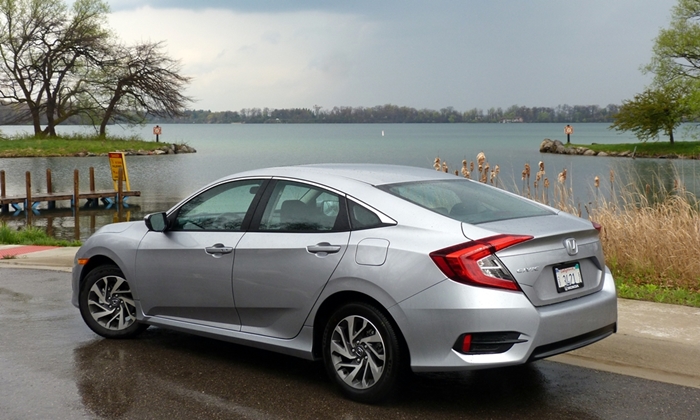
Too much going in the rear quarters, but the new Civic certainly gets noticed.
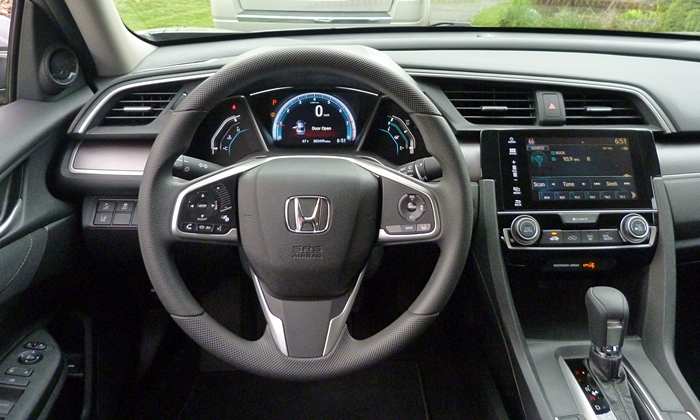
Appears stylish and hi-tech, but the Civic's infotainment interface requires too much tapping.
| Exterior styling |
 Better
Worse
Better
Worse
|
Inside and out, the ninth-generation Honda Civic's styling offended my sense of aesthetics. Just awful. Awful, awful, awful.
In comparison, the tenth-generation Civic's styling is a huge improvement. While the exterior will strike some as overwrought, the new sedan looks larger and more expensive than it is, and than competitors. Young people tend to love the look of it. One minor criticism: even on the Touring the wheels don't appear as upscale and sophisticated as the rest of the car.
The new Elantra has an attractive but forgettable exterior. Few people who don't frequent auto enthusiast sites will notice they're seeing a car they haven't seen before.
Given a shortage of "why to buy" slots, I'll also note the excellence of the new Civic's interior design here. The massive bi-level instrument panel from the 2006-2015 Civics has been replaced by a much more compact dash with refreshingly modern styling. While Honda's interior designers successfully dialed back their zany sci-fi tendencies, they also avoided producing a boringly generic interior (such as the one in the new Elantra). The new Civic's interior makes those in competitors seem unimaginative and even stodgy.
Interior materials are about as good as you'll find in the class. With a contrasting strip down the middle, the cloth on the seats in the EX look and feel nice enough that I didn't miss the leather of the EX-L and Touring.
The new Elantra's interior materials aren't as good. The hard plastic door panels look and feel cheap even for the class. They're my least favorite aspect of the car.
| Front seat room |
 Better
Worse
Better
Worse
|
From the driver seat the new Honda Civic feels especially roomy. Appearances aren't deceiving: the car has an inch or two more front shoulder room than most other small sedans, and about as much as you'll find in some midsize sedans. On paper the Mazda3 has as much shoulder room, but it feels narrower. Some competitors feel much narrower. In comparison, the new Civic's driving position seems like that of a midsize car.
In terms of specs, the Civic's rear seat is also roomier than most others. Owing to a somewhat low cushion and scant toe room beneath the front seats, though, I found it less comfortable than some others.
The Elantra isn't among these others. Its rear seat cushion is also too close to the floor to provide thigh support, plus its rear seat back is reclined too much for my taste. Even so, rear headroom is limited.
The new Civic's trunk can also hold more than the class average.
| Fuel economy |
 Better
Worse
Better
Worse
|
The new Honda Civic earned EPA ratings among the best in the class with both engines: 31 mpg city, 41 mpg highway with the 2.0-liter engine and 31/42 with the 1.5-liter turbo. With the 2.0-liter I observed suburban averages as high as 43 mpg and a 70-mph highway average around 42. My average for the entire week, including cold starts and idling while taking photos, was 31.8 mpg.
With a 2.0-liter engine, the 2017 Hyundai Elantra doesn't come within ten percent of the Honda's scores with a marginally competitive 28/37. Hyundai is adding an Eco variant with a 1.4-liter turbocharged engine. The Eco roughly ties the Civic with 32/40, but with only 128 horsepower it probably won't perform nearly as well.
The Mazda3's fuel economy is more competitive: 30/41 with a 2.0-liter engine and 28/39 with a strong 2.5-liter.
If you want a manual transmission, the Mazda can seem even better. First off, Honda and Hyundai currently offer a manual transmission only with their base trim levels and base engines, while Mazda offers a manual with both engines and all trim levels. MPG ratings for the Mazda3 with a manual are 29/41 with the 2.0 and 25/37 with the 2.5. With a manual the Honda's EPA ratings are 27/40 and the Hyundai's are 26/36.
Next year Honda will offer a manual transmission with additional engines and trim levels.
| |
Compared to the Elantra |
| Front seat support & comfort |
 Better
Worse
Better
Worse
|
Unlike in the Hyundai and Mazda, in the new Honda Civic the lumbar bulge cannot be adjusted. I didn't mind the Touring's front seats. Perhaps my spine was unusually flexible the day I drove it. Or perhaps the cloth seats are slightly different. Whatever the reason, for my upright build the Civic EX's lumbar bulge and headrest both jut too far forward. If your body shape differs from mine, your impressions of the seats might as well. But for years I've heard more complaints about Honda's seats than others. Try extensively before you buy.
| Controls and instruments |
 Better
Worse
Better
Worse
|
The new Honda Civic's infotainment display looks sleek, but an absence of knobs makes it overly difficult to change the volume or the channel. Tasks in general require multiple taps.
The climate controls do include knobs and buttons. But why are there two buttons to manage recirculation, but none for vent selection or the A/C? For these functions you must hit a button then tap on the display.
The more conventional controls in competitors, including the Mazda and the Hyundai, tend to be much easier to use.
Would I really not buy the Civic for this reason? No. But you might find the controls more irritating.
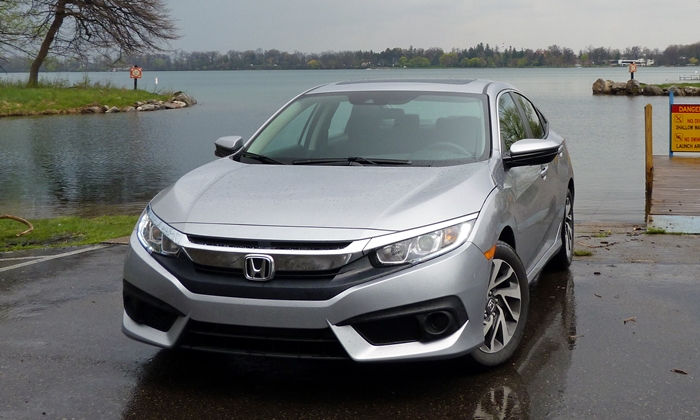
Plenty of chrome in Honda's latest face.
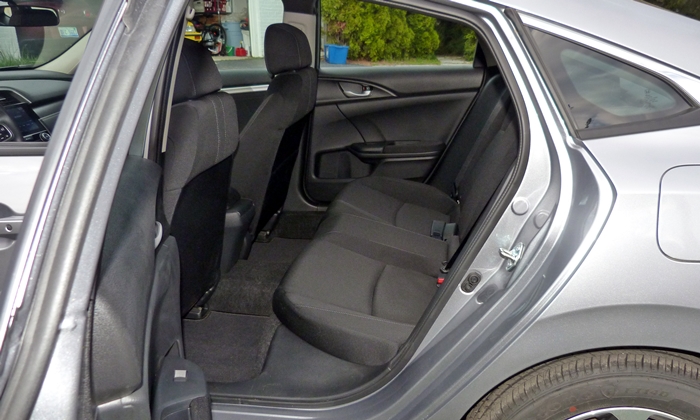
Plenty of rear seat room, but could be more comfortable.
| Quietness |
 Better
Worse
Better
Worse
|
The new Honda Civic is quieter inside than past Honda Civics. On coarse road surfaces and at highway speeds, though, you'll still experience somewhat more road roar than in some competitors. If you want a super-quiet car for long highway drives, the new Civic isn't your best choice. In around-town driving, though, it often sounded and felt like a more expensive car.
| |
Compared to the Elantra |
| Powertrain performance |
 Better
Worse
Better
Worse
|
Honda has tended to fit the Civic with smaller engines than you'll find in competitors. Only with the 2016 has the base engine grown to a full 2.0 liters, a size commonly offered elsewhere in the class for over a decade. The new 158-horsepower engine is a good one. I've already remarked on its competitive efficiency. But it's also plenty quick for any typical driving. Figure a little over eight seconds for a full-throttle run to 60 mph. I didn't often wish for more power.
The 2.0-liter engines in the Elantra (rated at 147 hp), and Mazda3 (155 hp) do not feel as strong. In the Mazda I much prefer the sound and feel of the 2.5 to the 2.0.
The above said, full-throttle isn't what the Civic's powertrain does best. The transmission is a CVT that accepts no manual input. Drive with a heavy foot and the transmission will hold the engine steady at high rpm. The resulting noise isn't nearly as annoying as that in the Honda Fit or Honda HR-V, which have smaller, buzzier engines, but it's still not noise anyone will be thrilled to hear.
The 174-horsepower 1.5-liter, Honda's first mass-market turbo, performs somewhat better. It can get to 60 about a second sooner, and because it has more power at lower rpm it generally sounds and feels more relaxed than the 2.0. Boost comes on smoothly with minimal lag. Still, the difference between the 2.0 and 1.5T is one of degree rather than kind. Driving enthusiasts will want to wait for upcoming high-performance variants of the new Civc, which will include a 306-horsepower Type R.
Given that the 1.5T when teamed with the CVT performed best in relatively casual driving, where the 2.0 also performs quite well, I don't see a major benefit to the 1.5T. If you want the additional features that come with the higher trim levels, get it. But I wouldn't spend more for these higher trim levels just to get the 1.5T engine.
| Handling |
 Better
Worse
Better
Worse
|
The new Honda Civic handles well much like it performs well. Push the sedan even somewhat hard, and you'll discover understeer and limited grip from the tires. Drive it like such cars are typically driven, though, and the moderately firm steering (with more heft than in past Civics) feels quick and somewhat sporty while the suspension remains composed and holds the intended line over uneven pavement. In typical driving, the Civic feels quite good.
In 2.0-liter form the Mazda3 similarly suffers from insufficiently grippy tires and doesn't feel significantly sportier than the Honda. I prefer the handling of the 2.5, with its more performance-oriented tires.
The new Elantra surprised me. When I tested Hyundai's previous compact sedan, I found its suspension very badly tuned. The 2011 Elantra handled vaguely, tossed about over wavy pavement, and jiggled much of the time. The 2017, though, handles and rides like a car tuned by Europeans. Compared to the Honda it feels more tightly damped, especially when driven with some vigor, yet it still rides very well (if with louder "thunks" from the tires over the small stuff). Switch the Elantra into sport mode, and its steering feels weightier than the Honda's, and provides at least as much feedback. At least in Limited trim the Hyundai's tires grip better than the Honda's. Pair the new Elantra's steering and suspension with a stronger engine, and it could be fun to drive.
With gas prices low, demand has been soft for compact sedans, even though many have become excellent all-around cars. The new Chevrolet Cruze, Hyundai Elantra, and Honda Civic all impressed me. While I'd personally prefer any of them in a much more sporting tune, they're all far ahead of the small sedans of even a few years ago.
The Honda Civic could use better tires and better seats, but delivers a compelling combination of styling, room, performance, fuel economy, reliability (if history repeats itself), and price. The Cruze and the Elanta both arguably have better suspension tuning, but this isn't enough to compensate for the Civic's advantages in other areas. The Mazda3? I remain a big fan of the s version, with a 2.5-liter engine and low-profile tires, but the i with the 2.0-liter didn't do it for me.
In the past, many people bought Honda Civics because they were a very safe bet. They were good cars with very low total costs of ownership. The new Civic is easily the best yet, and unless you find its driver seat uncomfortable or you can get a huge discount on something else (the dealer where I test drove the new Elantra was already offering a large discount), it's hard to think of a good reason to buy a competing sedan instead.
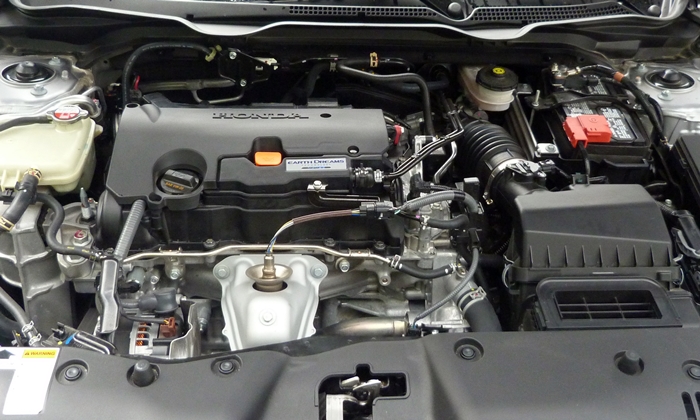
The 2.0-liter engine delivers very good performance and fuel economy.
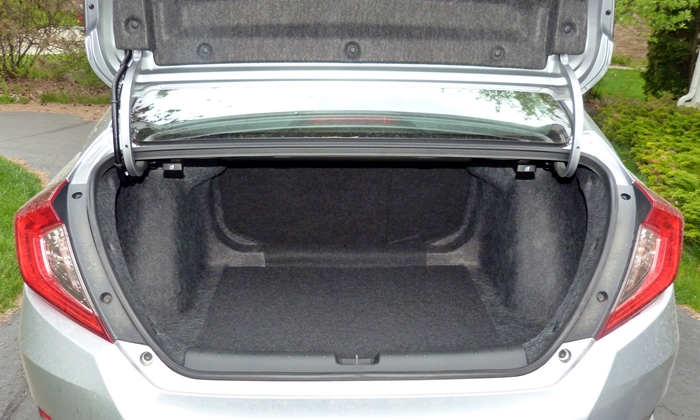
Among the largest trunks in the class.
See more 2016 Honda Civic photos
Honda provided an insured car for a week with a tank of gas. Diane Richmond (248-741-7815) of Suburban Mazda in Farmington Hills, MI, and Jim Cipriano (248-599-5923) of Feldman Hyundai in Waterford helpfully provided cars for comparison test drives.











